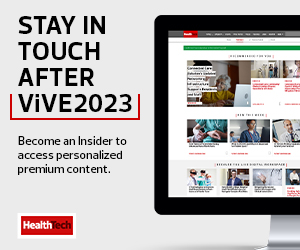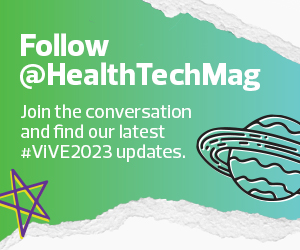1. The Importance of Optimizing Workflows with the EMR
At Allegheny Health Network, Chief Digital and Information Officer Dr. Ashis Barad is focused on optimizing the electronic medical record to improve operational workflows.
“If the EMR isn’t standardized and working optimally for schedules, registration and referrals, then that’s going to create a consumer experience where a patient goes online to book an appointment, and it’s not going to link to a real appointment, and it won’t work right,” he said.
Many provider identities are broken within the infrastructure. Barad pointed out that in some cases, patients may book an appointment and then get a call from that doctor’s office informing them that the doctor they booked an appointment with isn’t at that location.
Allegheny Health Network is working to standardize its data within the EMR. The next step will be to build intelligence on top of the data to help the organization gather rich insights. However, Barad said it’s not enough to have intelligence if the data isn’t put in front of the right person at the right time.
EXPLORE: What are modern data platforms, and how can they boost healthcare agility?
He envisions a more data-driven and interconnected future for healthcare. If a healthcare organization has access to payers’ data about patients, then it would have a fuller picture of patient health. For example, a child may have come in to see a doctor about an ear infection four times in the past year. However, if the doctor has access to payer data, they can see that the child was taken elsewhere to be treated for ear infections three other times in the same period, meaning that it may be time to recommend ear tubes.
The EMR should also have collected data about how the child’s family typically engages with the healthcare system, whether through a phone call, text or online message, so the doctor will know how best to reach out. The EMR should also have data that shows what days and times the patient’s family usually schedules appointments so the healthcare organization can recommend an available time to make the process easier.
Barad said that despite the data existing for organizations to be able to operate in this way, no health system is anywhere close to doing so because the systems of record are broken, and organizations aren’t building them that way.
He pointed out that marrying clinical, payer and consumer data is the way to enable operational efficiency.
Barad also said that engaging with clinicians early is key to digital transformation success. Watch the video to learn more:
#DigitalTransformation initiatives are more likely to succeed when clinicians are involved early in the process. @AHNtoday CDIO Dr. Ashis Barad explains how to engage with clinicians at #ViVE2023. pic.twitter.com/vIAsqgq6eD
— HealthTech Magazine (@HealthTechMag) March 27, 2023
2. Partnership Is Key to Digital Transformation in Healthcare
Todd Larson, consultant for workplace and public safety at HonorHealth, told HealthTech that the organization is partnering in the marketplace with companies like CDW to bring the joy of medicine back to clinicians rather than watching them burn out due to administrative burdens.
“Nurses spend so much time hands-on with the patient, but they spend the same amount of time in some type of administrative function,” said Larson. “If we can change that by bringing clinical coordination together with various roles, entities and support, then we can partner with companies like CDW so our clinicians can work with patients and not just a keyboard.”
Larson said it’s also important for healthcare leaders to look outside of the industry for ideas. As HonorHealth was creating its COVID-19 vaccination strategy, the organization looked at the Costco gas model to inform its crowd-flow planning.
MORE FROM ViVE: Health systems should maintain security and privacy as patient data grows.
“We realized that we should focus on the vaccine clinic as an event versus focusing on it as a healthcare appointment,” said Larson, adding that, from an overall efficiency standpoint, HonorHealth averaged 23 minutes per vaccine, including the 15-minute post-vaccine wait time to monitor patients for reactions.
While innovating, Larson pointed out that it’s important for healthcare organizations to think of their entire patient population. Much of the conversation at ViVE 2023 focused on digital-first strategies; however, not all patients want to interact with healthcare that way, especially those over the age of 70.
While younger patients may push for digital-first, Larson explained that that age group is not the one consuming the most healthcare. That’s why healthcare organizations have to balance new technologies and initiatives with the way their most-engaged patient population wants to interact with healthcare.
Larson also spoke at ViVE 2023 about HonorHealth’s HealthPath University and Internship program. Watch the video below to learn more.
HealthTech met up with Todd Larson @HonorHealth during #ViVE2023 to learn more about the organization's HealthPath University and Internship program. pic.twitter.com/JfCEUygfSE
— HealthTech Magazine (@HealthTechMag) March 28, 2023
3. Cost Increases and Staff Shortages Drive the Need for Change
The cost of doing business in healthcare is rising due to inflation, supply chain issues and clinical staff shortages.
“Business problems very much become IT problems,” said Tressa Springmann, senior vice president and chief information and digital officer at LifeBridge Health.
However, she said the industry’s financial landscape has presented an opportunity as it has become the burning platform for change.
“We have to reinvent ourselves, and we have to reinvent ourselves from the inside out,” said Springmann.
How can #healthcare organizations set themselves up for digital transformation success in a complex #HealthIT landscape? Tressa Springmann @LBHealth explained at #ViVE2023: pic.twitter.com/f6xW338Li8
— HealthTech Magazine (@HealthTechMag) March 28, 2023
One way to do that is by automating nonvalue-added, redundant tasks. Springmann pointed out that automation, machine learning and artificial intelligence would assist clinical and other staff rather than replace them.
“Maybe a few years ago, it would have taken more off of a person and they would have left the organization, but today we have so many vacancies,” she said. “It’s really just allowing our teams to work a little more effectively.”
Springmann explained that in response to workforce constraints, health IT leaders need to apply creative uses of technology. In addition to automation, healthcare organizations can take some of the workload off healthcare staff by pushing some tasks onto the consumer. This has happened in other industries, such as fast-food restaurants that ask customers to fill up their own soda or gas stations that allow customers to pump their own gas.
“That self-service not only allows choice in what otherwise has not been seen as a consumer-friendly market, but it takes the workload off otherwise constrained resources in the healthcare system,” she said. “So that puts an accelerant on all our digital investments.”
Springmann emphasized that organizations implementing new technologies need to ensure a balanced governance process with universal support and strategies around quality and patient engagement.
Keep this page bookmarked for our coverage of ViVE 2023. Follow us on Twitter at @HealthTechMag and join the conversation at #ViVE2023.













